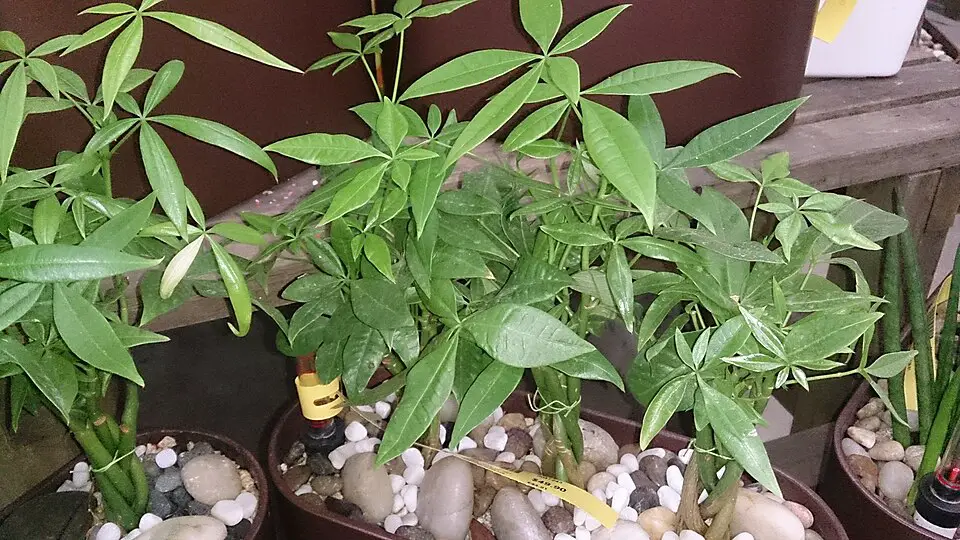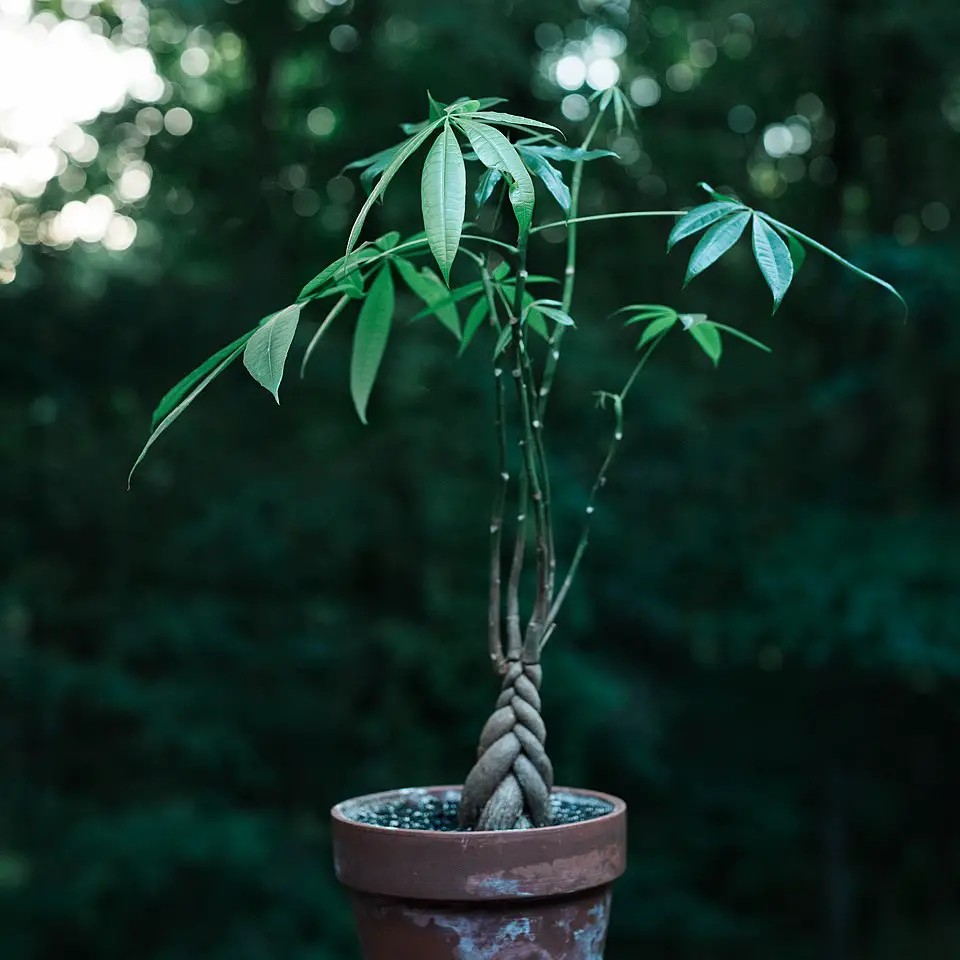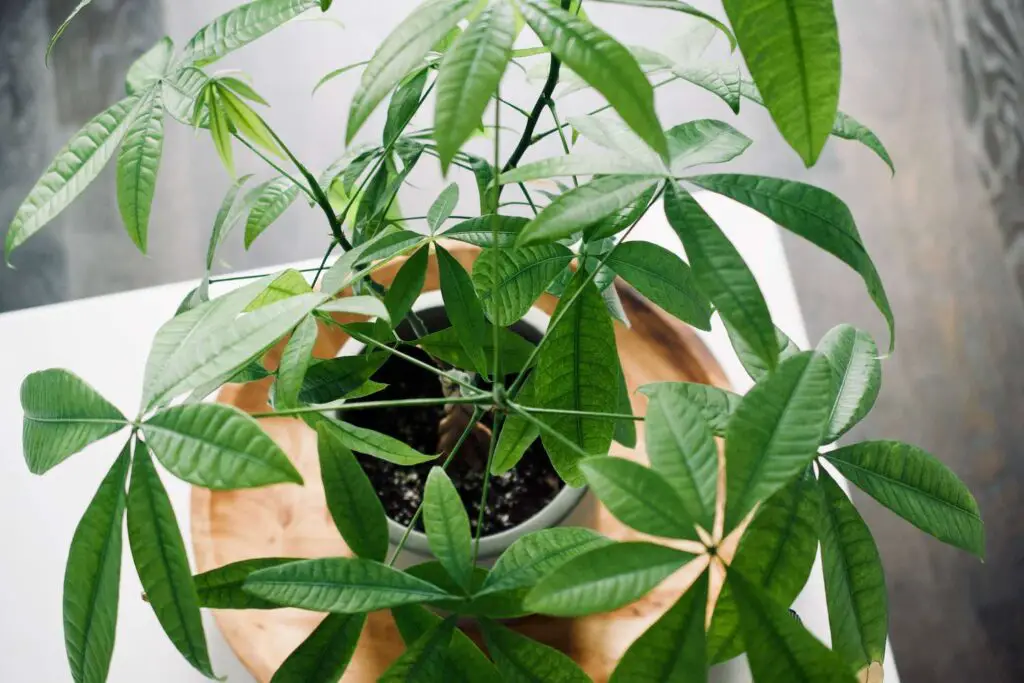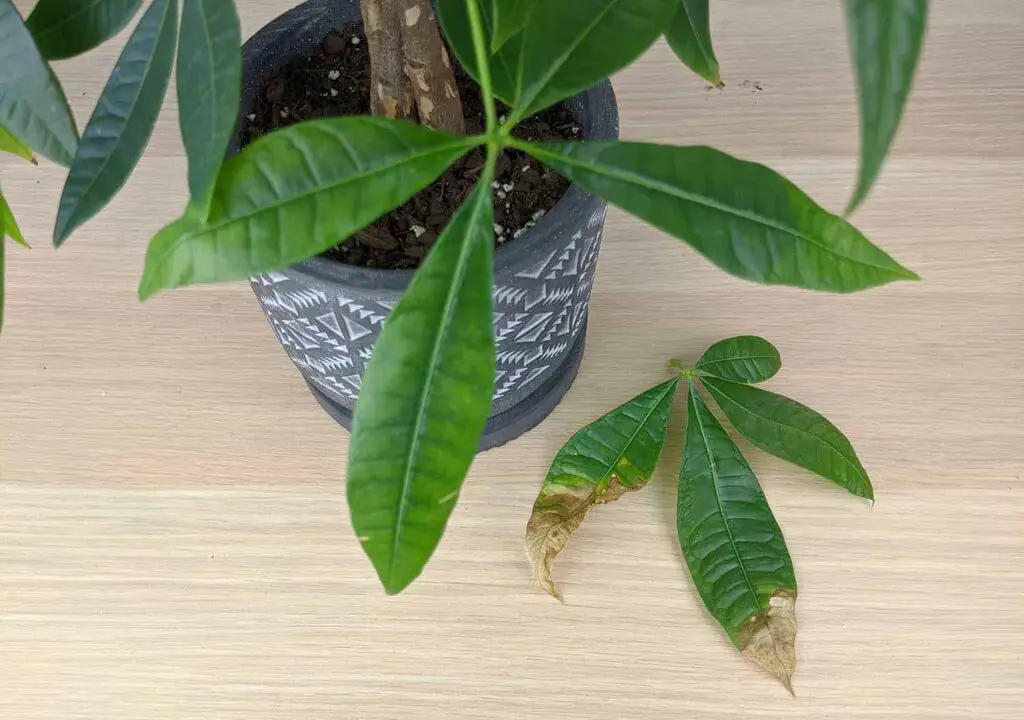Money tree leaves curl due to factors like improper watering, low humidity, pest infestations, or inadequate light. Identifying the cause is crucial for restoring plant health and ensuring vibrant growth.
Understanding Money Trees
The money tree, scientifically known as Pachira aquatica, is a popular houseplant known for its unique braided trunk and shiny, green leaves. Many people believe it brings good luck and prosperity. Native to Central and South America, this plant thrives in warm, humid environments. However, it can experience various issues that affect its health, including leaf curling.

Leaf curling is a common concern for indoor gardeners. It can be a sign of stress in the plant, often indicating that something in its environment is not quite right. Understanding the potential causes of this problem is essential for maintaining a healthy money tree.
Common Causes of Leaf Curling
Several factors contribute to the curling of money tree leaves. Here are some of the most common causes:
- Improper Watering: Overwatering or underwatering can lead to significant stress on the plant. Too much water can suffocate roots, while insufficient water prevents proper nutrient absorption.
- Low Humidity: Money trees prefer high humidity levels. Dry indoor air can cause leaves to curl and drop.
- Pest Infestations: Pests like spider mites and aphids can attack the leaves, leading to curling and wilting.
- Inadequate Light: Money trees thrive in bright, indirect light. Insufficient light can cause leaves to curl as the plant struggles to photosynthesize.
- Nutrient Deficiency: A lack of essential nutrients can lead to poor health and leaf curling.
Diagnosing Leaf Curling Issues
To effectively treat leaf curling, it’s important to diagnose the specific issue affecting your money tree. Here are some steps to help you identify the cause:

- Check Watering Habits: Assess how often you water your plant. Make sure the pot has drainage holes and that excess water can escape.
- Examine Humidity Levels: Use a hygrometer to measure indoor humidity. If levels are low, consider using a humidifier or placing a tray of water near the plant.
- Inspect for Pests: Look closely at the leaves and stems for signs of pests. You may notice small webs or tiny insects.
- Evaluate Light Conditions: Observe where your plant is located. Ensure it receives bright but indirect sunlight for several hours each day.
- Assess Nutrient Levels: Consider whether you have fertilized your money tree recently. A balanced, water-soluble fertilizer can help if nutrient deficiency is suspected.
Treatment Options
Once you have identified the cause of leaf curling, you can take steps to rectify the issue. Here are some treatment options based on common problems:
| Cause | Solution |
|---|---|
| Overwatering | Allow soil to dry out before watering again. Ensure proper drainage. |
| Underwatering | Water thoroughly, allowing excess to drain out. |
| Low Humidity | Increase humidity by misting leaves or using a humidifier. |
| Pests | Treat with insecticidal soap or neem oil. |
| Inadequate Light | Relocate to a brighter area with indirect sunlight. |
Taking action quickly can help your money tree recover and return to its healthy state. Regular monitoring of your plant’s environment will also prevent future issues related to leaf curling.
Preventing Leaf Curling in Money Trees
While diagnosing and treating curling leaves is important, prevention is the best strategy for maintaining a healthy money tree. Implementing good care practices can significantly reduce the likelihood of leaf curling. Below are several preventive measures to consider:

Proper Watering Techniques
Watering is one of the most crucial aspects of plant care. To prevent issues related to overwatering or underwatering, follow these guidelines:
- Check Soil Moisture: Always check the top inch of soil before watering. If it feels dry, it’s time to water.
- Use Well-Draining Soil: Ensure your money tree is planted in a mix that drains well. A combination of potting soil and perlite works well.
- Water Less in Winter: Money trees require less water during their dormant period in winter. Reduce watering frequency accordingly.
Maintaining Humidity Levels
Money trees thrive in high humidity environments. Here are tips to maintain appropriate humidity levels:
- Misting: Lightly mist the leaves regularly to increase humidity around the plant.
- Humidity Trays: Place a tray filled with water and pebbles under the pot. As the water evaporates, it increases humidity.
- Group Plants Together: If you have multiple houseplants, grouping them can create a more humid microenvironment.
Light Requirements
Providing the right amount of light is essential for the health of your money tree. Follow these tips to ensure proper lighting:
- Avoid Direct Sunlight: Place your money tree in bright, indirect light. Direct sunlight can scorch the leaves.
- Rotate Regularly: Rotate the pot every few weeks so that all sides of the plant receive equal light exposure.
- Use Grow Lights: If natural light is insufficient, consider using grow lights to supplement lighting, especially during winter months.
Pest Management Strategies
Pest infestations can lead to severe damage to your money tree, causing leaf curling among other issues. Effective pest management is critical. Here are strategies to keep pests at bay:

Regular Inspection
Routine checks for pests can help catch infestations early. Look for signs such as:
- Discoloration or spots on leaves
- Visible insects, such as spider mites or aphids
- Webbing on leaves or stems
Natural Pest Control Methods
If you discover pests, consider these natural treatment options:
- Insecticidal Soap: Spray your plant with insecticidal soap to kill soft-bodied insects.
- Neem Oil: This natural pesticide can repel and kill various pests while being safe for plants.
- Diatomaceous Earth: Sprinkling this powder on the soil surface can deter crawling insects.
Nutrient Management
Nutrient deficiencies can also lead to leaf curling. Ensuring your money tree receives adequate nutrients will support its overall health. Here’s how to manage nutrients effectively:
Selecting the Right Fertilizer
Using a balanced fertilizer can provide essential nutrients. Consider the following:
- Frequency: Fertilize your money tree every four to six weeks during the growing season (spring and summer).
- Type: Use a balanced liquid fertilizer with an N-P-K ratio (Nitrogen-Phosphorus-Potassium) of approximately 10-10-10.
- Dilution: Always dilute fertilizers according to package instructions to avoid over-fertilization.
Signs of Nutrient Deficiency
Be aware of signs that may indicate a nutrient deficiency, such as:
- Pale or yellowing leaves
- Sparse leaf growth
- Stunted growth or leggy appearance
>
Addressing these issues quickly can help maintain a vibrant and healthy money tree, minimizing the risk of leaf curling in the future.
Identifying Other Problems Affecting Money Trees
While leaf curling is a significant issue, other problems can also affect the health of your money tree. Recognizing these issues early can help you take appropriate measures to ensure the plant remains healthy. Below are some common problems and their symptoms.
Root Rot
Root rot is a serious condition that occurs when the roots of a plant are overwatered and begin to decay. It can lead to severe damage if not addressed promptly. Here are some signs of root rot:
- Yellowing Leaves: Leaves may turn yellow and fall off as the roots fail to supply nutrients.
- Wilting: The plant may appear wilted, despite being watered.
- Soggy Soil: The soil will feel excessively wet and may emit a foul odor.
If you suspect root rot, it is crucial to act quickly. Remove the plant from its pot, trim away any black or mushy roots, and repot it in fresh, dry soil.
Leaf Spotting
Leaf spotting can result from various factors, including fungal infections, bacterial diseases, or improper watering practices. Symptoms include:
- Dark Brown or Black Spots: These may appear on the leaves, often surrounded by yellow halos.
- Wilting Leaves: Affected leaves may also droop or wilt.
- Leaf Drop: In severe cases, the leaves may drop prematurely.
To manage leaf spotting, ensure proper air circulation around the plant, avoid overhead watering, and remove any affected leaves to prevent the spread of disease.
Environmental Factors Impacting Health
The environment in which your money tree resides plays a significant role in its overall health. Several environmental factors can contribute to issues like leaf curling or other problems. Here are key areas to consider:
Temperature Fluctuations
Money trees prefer stable temperatures between 65°F and 75°F (18°C to 24°C). Sudden temperature changes can stress the plant, leading to leaf curling. Consider the following:
- Avoid Drafts: Keep your money tree away from doors, windows, and air conditioning vents that may cause drafts.
- Consistent Temperature: Try to maintain a consistent temperature throughout the year.
Air Circulation
Good air circulation is essential for preventing mold and pests. Poor air circulation can increase humidity around the plant, creating a favorable environment for fungal growth. To enhance air circulation:
- Space Plants Apart: Ensure enough space between plants to allow for airflow.
- Avoid Overcrowding: Do not place too many plants in one area.
Seasonal Changes and Their Effects
Seasonal changes can also impact the health of your money tree. Understanding how different seasons affect your plant can help you adjust your care routine accordingly.
Spring and Summer Care
The growing season for money trees is in spring and summer. During this time, they require more water and nutrients. Here are some tips for seasonal care:
- Increase Watering: As temperatures rise, increase watering frequency while ensuring proper drainage.
- Add Fertilizer: Fertilize every four to six weeks to support growth.
Fall and Winter Care
In fall and winter, money trees enter a dormant phase. Their care needs change significantly:
- Reduce Watering: Cut back on watering as the plant requires less moisture during dormancy.
- Avoid Fertilizing: Fertilization should be minimized or stopped during these months.
By adjusting your care routine according to seasonal changes, you can help your money tree thrive through all seasons.
When to Seek Professional Help
If y
ou have tried various methods to address leaf curling and other issues without success, it may be time to seek professional advice. Consider contacting a local horticulturist or plant specialist if you notice:
- Persistent pest infestations that do not respond to treatment
- Continuous leaf curling despite proper care
- A significant decline in overall plant health
A professional can provide tailored advice and treatment options specific to your money tree’s condition.
Understanding the Lifecycle of Your Money Tree
A money tree’s lifecycle involves various stages, each requiring specific care. Understanding these stages can help you provide better care and prevent issues such as leaf curling. The lifecycle begins with the seedling stage, where proper watering and light are crucial.
Seedling Stage
During the seedling stage, your money tree will need consistent moisture, warmth, and gentle light. Here are some tips for caring for seedlings:
- Watering: Keep the soil consistently moist but not soggy. Overwatering can lead to root rot.
- Light: Provide bright, indirect sunlight to promote healthy growth.
- Humidity: Maintaining higher humidity levels will support seedling development.
Growth Stage
As your money tree matures, its needs will change. During the growth stage, focus on the following:
- Fertilization: Begin fertilizing every four to six weeks using a balanced fertilizer.
- Repotting: Consider repotting your tree into a larger pot as it grows to give the roots more space.
- Pruning: Regularly prune to encourage bushier growth and remove any dead or unhealthy leaves.
Mature Stage
In the mature stage, your money tree will require less frequent watering and feeding. Here are some key points to remember:
- Water Less Frequently: As the plant establishes itself, allow the topsoil to dry out between waterings.
- Seasonal Adjustments: Adapt care routines based on seasonal changes, as discussed in previous sections.
Additional Tips for Thriving Money Trees
Beyo
nd addressing leaf curling and other common problems, here are additional tips for ensuring your money tree remains healthy:
Regular Monitoring
Consistent monitoring of your plant is vital. Check for signs of distress regularly. Look for changes in leaf color, texture, and overall appearance.
Creating a Care Schedule
A care schedule can help you stay organized. Consider making a chart that outlines when to water, fertilize, and inspect your plant:
- Watering Frequency: Adjust based on season and environmental conditions.
- Fertilization Schedule: Mark dates for applying fertilizer during the growing season.
- Pest Inspections: Set reminders to inspect for pests bi-weekly or monthly.
Educating Yourself Continually
Stay informed about the best practices for caring for money trees. Books, online resources, and gardening workshops can provide valuable insights and updates on plant care techniques.
Final Thoughts
Caring for a money tree involves understanding its specific needs and responding to any potential issues promptly. Leaf curling is just one of many signs that your plant may need attention. By providing proper water, light, humidity, and nutrients, you can ensure that your money tree thrives.
The journey of nurturing a money tree can be rewarding. By following the guidelines outlined in this article, you can prevent common problems and promote healthy growth. Remember to regularly monitor your plant’s health and take action quickly if you notice any signs of distress.
In conclusion, with patience and attentiveness, your money tree can flourish and bring beauty to your home while serving as a symbol of prosperity and good fortune.
